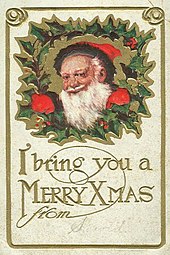Xmas Does Not Take ‘Christ’ Out of Christmas
Many people get bent out of shape when they see Xmas. They think it’s a way of removing Jesus Christ from Christmas. “Every year you see the signs and the bumper stickers saying, ‘Put Christ back into Christmas’ as a response to this substitution of the letter X for the name of Christ.” Nothing could be further from the truth.
“Christ” is a Greek word for the Hebrew word “anointed one” or “Messiah.”
The Greek word for Christ is Χριστος. The Greek alphabet does not have the letters “c” or “h.” You will find a “k” (kappa) and an “h” sound that looks like a single opening quotation mark – ‘.
Notice that the Greek word Χριστος begins with what looks like an X, the 24th letter of the English alphabet, but it’s really the Greek letter chi = Χ.
R.C. Sproul writes that “the idea of X as an abbreviation for the name of Christ came into use in our culture with no intent to show any disrespect for Jesus.” Using a single letter to represent a title or name is not unusual. For example, the “R.C.” in R.C. Sproul stands for Robert Charles and is not meant to demean the man.
Most Christians are familiar with the use of the symbol of the fish as a way to represent Jesus Christ. The Greek word for fish in Greek is ιχθύς (lower case letters) and ΊΧΘΥΣ (upper case letters). Each letter represents a Greek word that in abbreviated form describes the redemptive and relational work of Jesus: Ίησοῦς Χριστός Θεοῦ Υἱός Σωτήρ: (’Iēsous Christos Theou Yios Sōtēr) = “Jesus Christ, Son of God, Savior” or “Jesus Christ, Son, God, Savior.”
“The early Christians would take the first letter of each of those words and put those letters together to spell the Greek word for fish. That’s how the symbol of the fish became the universal symbol of Christendom,” Sproul writes.
There is nothing new in using a single letter to represent Jesus Christ. Consider the use of X and P = Chi Rho. The Χ (Chi), as we’ve seen, is an abbreviation for Christ representing the first letter in the word Χριστός, and the letter “P” (Rho) represents the second letter in upper case form. What looks like a “P” to us is actually the Greek letter for “R.”
The Chi-Rho is common in Christian art and worship. In many of the examples, you will also find the use of A and W, the first and last letters of the Greek alphabet, Alpha and Omega (Ἄλφα καὶ τὸ Ὦ: Rev. 1:8; 21:6; 22:13; Isa. 41:4), also descriptive of Jesus, and found to the left and right of the XP.
The following is from A Word in Edgewise by David B. Capes:
“Earliest versions of writing Christmas as ‘Xmas’ in English go back to the Anglo-Saxon Chronicle (about 1100). This predates the rise of secularism by over 600 years. The Oxford English Dictionary cites the use of ‘X’- for ‘Christ’ as early as 1485. In one manuscript (1551) Christmas is written as ‘X’temmas.’ English writers from Lord Byron (1811) to Samuel Coleridge (1801) to Lewis Carroll (1864) used the spelling we are familiar with today, Xmas.’

“The origin of ‘Xmas’ does not lie in secularists who are trying to take Christ out of Christmas, but in ancient scribal practices adopted to safeguard the divine name and signal respect for it. . . . No doubt some people today use the abbreviated form to disregard the Christian focus of the holy-day, but the background tells a different story, a story of faithful men and women showing the deep respect they have for Jesus at this time of year.”
So don’t be alarmed and disgruntled when you see Xmas. If the issue comes up in a discussion, do a little “Did you know. . .”





